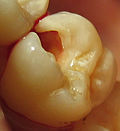Dental restoration
Dental Restoration refers to the process of restoring the function, integrity, and morphology of missing tooth structure, which may have been caused by caries or external trauma, such as chipping or cracking a tooth. This process is typically carried out by a dentist using a variety of materials and techniques.
Types of Dental Restoration[edit]
There are several types of dental restoration, each suited to different circumstances and patient needs. These include:
- Fillings: These are the most common type of dental restoration. Fillings are used to fill a cavity in a tooth caused by decay. The most common types of materials used for fillings are amalgam, composite resin, and porcelain.
- Crowns: A crown is a type of dental restoration which completely caps or encircles a tooth or dental implant. Crowns are often used when a large cavity threatens the ongoing health of a tooth.
- Bridges': A bridge is a type of dental restoration used to replace one or more missing teeth by joining an artificial tooth definitively to adjacent teeth or dental implants.
- Dentures: Dentures are prosthetic devices constructed to replace missing teeth, and are supported by the surrounding soft and hard tissues of the oral cavity.
- Veneers: A veneer is a layer of material placed over a tooth, either to improve the aesthetics of a tooth or to protect the tooth's surface from damage.
Materials Used in Dental Restoration[edit]
Various materials can be used for dental restorations, including:
- Amalgam: This is a common material used in fillings. It is durable and has a long lifespan, but its silver color can be noticeable when you laugh or speak.
- Composite Resin: This is a tooth-colored filling material that may be used to restore decayed teeth.
- Porcelain: This material is often used for crowns and veneers. It is strong, durable, and can be made to match the color of your natural teeth.
- Gold: Gold is often used for crowns, inlays, and onlays. It is durable and has a long lifespan, but it is more noticeable than other materials.
Procedure of Dental Restoration[edit]
The procedure for dental restoration will depend on the type of restoration needed. However, most dental restorations will involve the following steps:
- Examination: The dentist will examine your teeth to determine the extent of the decay or damage and the best type of restoration for your situation.
- Preparation: The dentist will prepare the tooth for restoration. This may involve removing decay, reshaping the tooth, or taking impressions for a crown, bridge, or denture.
- Placement: The dentist will place the restoration, which may involve filling a cavity, cementing a crown, or fitting a denture.
- Finishing: The dentist will finish the restoration by polishing the filling, crown, or denture and making any necessary adjustments to ensure a proper fit and comfortable bite.
See Also[edit]
-
Dental restoration
-
Inlay on model
-
G.V. Black
-
Dental restoration
-
Onlay
Ad. Transform your life with W8MD's Budget GLP-1 injections from $75


W8MD offers a medical weight loss program to lose weight in Philadelphia. Our physician-supervised medical weight loss provides:
- Weight loss injections in NYC (generic and brand names):
- Zepbound / Mounjaro, Wegovy / Ozempic, Saxenda
- Most insurances accepted or discounted self-pay rates. We will obtain insurance prior authorizations if needed.
- Generic GLP1 weight loss injections from $75 for the starting dose.
- Also offer prescription weight loss medications including Phentermine, Qsymia, Diethylpropion, Contrave etc.
NYC weight loss doctor appointmentsNYC weight loss doctor appointments
Start your NYC weight loss journey today at our NYC medical weight loss and Philadelphia medical weight loss clinics.
- Call 718-946-5500 to lose weight in NYC or for medical weight loss in Philadelphia 215-676-2334.
- Tags:NYC medical weight loss, Philadelphia lose weight Zepbound NYC, Budget GLP1 weight loss injections, Wegovy Philadelphia, Wegovy NYC, Philadelphia medical weight loss, Brookly weight loss and Wegovy NYC
|
WikiMD's Wellness Encyclopedia |
| Let Food Be Thy Medicine Medicine Thy Food - Hippocrates |
Medical Disclaimer: WikiMD is not a substitute for professional medical advice. The information on WikiMD is provided as an information resource only, may be incorrect, outdated or misleading, and is not to be used or relied on for any diagnostic or treatment purposes. Please consult your health care provider before making any healthcare decisions or for guidance about a specific medical condition. WikiMD expressly disclaims responsibility, and shall have no liability, for any damages, loss, injury, or liability whatsoever suffered as a result of your reliance on the information contained in this site. By visiting this site you agree to the foregoing terms and conditions, which may from time to time be changed or supplemented by WikiMD. If you do not agree to the foregoing terms and conditions, you should not enter or use this site. See full disclaimer.
Credits:Most images are courtesy of Wikimedia commons, and templates, categories Wikipedia, licensed under CC BY SA or similar.
Translate this page: - East Asian
中文,
日本,
한국어,
South Asian
हिन्दी,
தமிழ்,
తెలుగు,
Urdu,
ಕನ್ನಡ,
Southeast Asian
Indonesian,
Vietnamese,
Thai,
မြန်မာဘာသာ,
বাংলা
European
español,
Deutsch,
français,
Greek,
português do Brasil,
polski,
română,
русский,
Nederlands,
norsk,
svenska,
suomi,
Italian
Middle Eastern & African
عربى,
Turkish,
Persian,
Hebrew,
Afrikaans,
isiZulu,
Kiswahili,
Other
Bulgarian,
Hungarian,
Czech,
Swedish,
മലയാളം,
मराठी,
ਪੰਜਾਬੀ,
ગુજરાતી,
Portuguese,
Ukrainian




